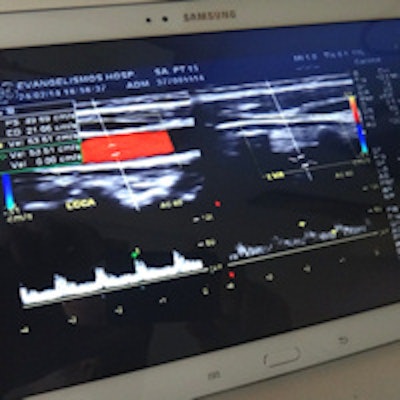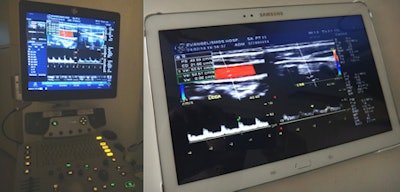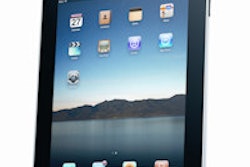
Using a wireless system that can provide real-time image streaming in high definition, mobile devices such as tablet computers can be used for remote interpretation of complete ultrasound examinations, researchers from Evangelismos Hospital in Athens, Greece, recently reported.
With their internally developed live-streaming wireless system, the Greek team found nearly 99% interobserver agreement between a radiologist performing live ultrasound exams and a second reader reviewing the studies in real-time from a tablet PC at another location.
The researchers set out to determine if a remote real-time wireless review system could be sufficient for medical imaging and diagnosis. They also wanted to verify the feasibility of remotely diagnosing complete ultrasound examinations that were performed elsewhere, said presenter Dr. Vasileios Moustakas. He shared the group's results during a scientific session at the RSNA 2014 meeting in Chicago.
Viewing in real-time
To provide the best possible diagnosis of ultrasound images, it's important to be able to view the complete examination in real-time instead of static images, Moustakas said.
The streaming image viewing system could be used when the ultrasound examination is performed by a resident or sonographer or when a second, more experienced review is needed in real-time, such as in remote areas or on the battlefield, he said. It could also be used when performing contrast-enhanced ultrasound (CEUS) studies.
"Using the system, a more experienced radiologist in the use of CEUS could take part in the examination, even if he's not situated in the hospital during the exam," Moustakas said.
The group's live-streaming wireless system has three components: a hardware video compression device that provides a 1080p high-definition video stream, a Wi-Fi router capable of connecting to HDSPA+/LTE (4G) mobile networks, and a Samsung tablet computer featuring an octacore central processing unit and a 10.1-inch 2560 x 1600 WQXGA display.
 The wireless system makes use of a hardware video compression device that provides full high-definition video streaming to tablets, PCs, or laptops. Image and videos courtesy of Dr. Vasileios Moustakas.
The wireless system makes use of a hardware video compression device that provides full high-definition video streaming to tablets, PCs, or laptops. Image and videos courtesy of Dr. Vasileios Moustakas.All types of video outputs are supported, and even an old ultrasound scanner can be connected to the video compression device without any issues, Moustakas said. Exams can then be visualized remotely in real-time using a PC, laptop, smartphone, or tablet.
"We chose to use a tablet because it's lightweight and provides a relatively good display quality and size," he said.
The researchers said their user interface is easy to use.
"Literally at the touch of a button, the dedicated application on the tablet starts up and automatically establishes the best possible connection," Moustakas said.
Furthermore, the real-time transmission system is lightweight and can fit into a small backpack.
"If already set up correctly, it can be deployed in two to three minutes," he said. "This makes it particularly easy to transport and use in remote areas or in emergency situations."
 
Live-streaming wireless system for ultrasound. |
To test the system, a consultant performed 42 complete ultrasound examinations (18 abdominal, 10 carotid, six leg vein, five leg artery, and three thyroid) on 37 patients for various indications. These exams produced a total of 545 results, including organ measurements, echogenicity of normal findings and lesions, degree of blood perfusion, and suggested diagnosis.
Exams were reviewed remotely in real-time by a second reader in another area; there was no contact between the remote reader and the examining doctor. The researchers then compared the independent double-blinded reports and also assessed the image quality on the tablet compared with the ultrasound machine image:
- Complete interobserver agreement: 538/545 (98.7%)
- Contradicting results: 7/545 (1.3%)
The group attributed the few contradicting results to different evaluations of liver/kidney echogenicity and thyroid nodule perfusion.
"These data often present discrepancies between different examiners on the same monitor," Moustakas said.
Most evaluated parameters demonstrated good interobserver agreement. Furthermore, real-time wireless streaming did not affect image quality and, therefore, didn't alter the diagnosis, he said.
The system also transmits live stereo audio at the same time as the video stream, enabling its use in arterial and venous Doppler ultrasound, the researchers noted.
 
The wireless system sends live audio and video simultaneously. |
"The system in our tests was configured to transmit only the sound that the ultrasound machine produces," he said. "However, if requested, the environmental sound [including the voice of the examiner] can also be easily transmitted in the same stream."




















